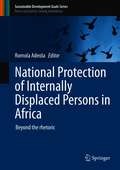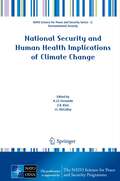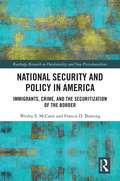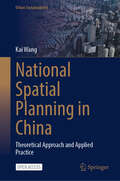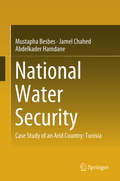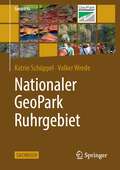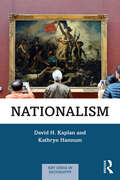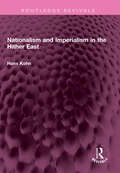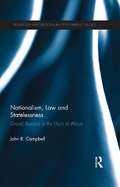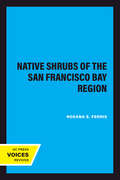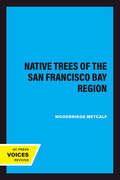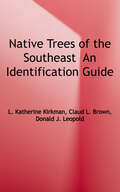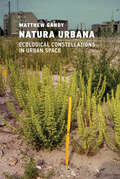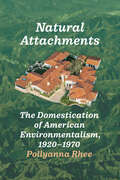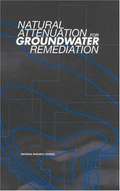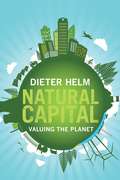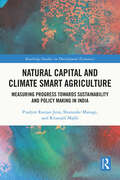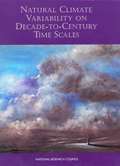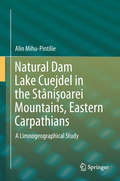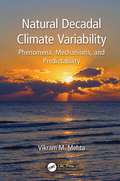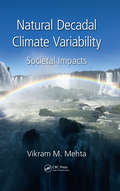- Table View
- List View
National Protection of Internally Displaced Persons in Africa: Beyond the rhetoric (Sustainable Development Goals Series)
by Romola AdeolaThis volume examines the protection of internally displaced persons (IDPs) through an interdisciplinary lens, with a focus on IDPs in Africa. The novelty of this book resonates from the fact that it explores national perspectives on internal displacement, with the aim of providing a well-grounded engagement on the subject of internal displacement, for which very little exists. The chapter authors are drawn from various disciplines and institutional backgrounds, and provide context-based analysis and examine the situation in countries with significant population displacement. The work is a timely engagement, as the issue of internal displacement has emerged as a pertinent concern in Africa. Each of the chapters in this book draw on significant context-based knowledge and on issues for which there is a need for pertinent attention across the African countries. This book will be a significant reference point for researchers, professors, practitioners, judges, policy makers, international organizations, regional bodies, lawyers and scholars in the field of migration, forced migration, and regional institutions.
National Security and Human Health Implications of Climate Change
by Harindra Joseph Fernando J. L. Mcculley Z. B. KlaićClimate change has been identified as one of the greatest threats to humanity of all times. In addition to producing adverse environmental conditions such as rising sea level, drought, crop failure, vector-borne diseases, extreme events, degradation of water/air quality and heat waves, climate change is also considered a threat multiplier that leads to local and international conflicts and armed interventions. Urban areas may bear the brunt of climate change, as they are the centers of human habitation, anthropogenic stressors and environmental degradation, and the ensuing health impacts are of grave societal concern. The papers in this volume span a suite of climate change repercussions, paying particular attention to national security and human health aspects. It is an outcome of a NATO Advanced Research Workshop held during April 28-30, 2011 in Dubrovnik, Croatia, sponsored by the NATO Science for Peace and Security Program. The contributions cut across the elements of modeling, natural, political and social sciences, engineering, politics, military intervention, urban planning, industrial activities, epidemiology and healthcare.
National Security and Policy in America: Immigrants, Crime, and the Securitization of the Border (Routledge Research on Decoloniality and New Postcolonialisms)
by Wesley S. McCann Francis D. BoatengThis book investigates the strategic use of America’s historical crime control, counterterrorism, national security and immigration policies as a mechanism in the modern-day Trump administration to restrict migration and refugee settlement with a view of promoting national security and preservation. National Security and Policy in America critically explores how American culture, neocolonial aspirations, and indifference towards others negatively impact long-term global security. This book examines immigration and security policies and their origins, purpose, impact, and evolution vis-à-vis the recently imposed ‘travel ban’ and proposed border wall across the Southern border, as well as how foreign policy influenced many of the migration flows that are often labeled as security risks. The book also seeks to understand why immigration has been falsely associated with crime, terrorism, and national insecurity, giving rise to counterproductive policies, despite evidence that immigrants face intolerance and turmoil due to the powerful distinctions between them and the native-born. This book uses an interdisciplinary framework in examining the U.S.’ current response to immigration and security and will thus appeal to undergraduate and graduate students of law, social justice, criminology, critical theory, neo-colonialism, security studies, policing, migration, and political science, as well as those interested in the practical questions of public administration.
National Spatial Planning in China: Theoretical Approach and Applied Practice (Urban Sustainability)
by Kai WangThis open access book conducts systematic and comprehensive research on urban spatial development problems in China from territorial perspectives, based on the scientific theory on human settlements environment. By integrating the theories of globalization, spatial planning, state intervention, and beyond, the author systematically sorts out both domestic and foreign urban spatial planning theories at national levels. Moreover, population, industries, natural resources, ecological environments, and management mechanisms involved during the urbanization and urban development process were analyzed in order to propose the theory and methods of national spatial planning. This book is recommended for researchers and practitioners in the fields of human settlement environment, urban, and regional planning; graduate students as well as teachers of urban planning, geography, architecture, regional science, and other related majors in universities, and public officials.
National Water Security: Case Study Of An Arid Country: Tunisia
by Mustapha Besbes Jamel Chahed Abdelkader HamdaneThis book shows how the change of water paradigm has become urgent, and provides evidence for new policies that expand water balance to green and virtual water. The issue of water security concerns drinking water supply but also food safety, linked to agricultural policy. Both rain-fed and irrigated agriculture play complementary roles in food security, and the water issue implies a holistic view of water resources. This view constitutes the book's backstory. The reader will find original ideas that can be applied everywhere because the example of Tunisia is typically a basis to illustrate a universally prevalent situation. The book deals with other important issues: desalination, wastewater recycling, water quality, groundwater overdraft, water savings, governance, knowledge valuing, education, information: upgrading the whole water systems for the future implies emancipation of the whole society.
Nationaler GeoPark Ruhrgebiet (Geoparks)
by Volker Wrede Katrin SchüppelRohstoffland Ruhrgebiet – Geologie erleben Ungewöhnliche Landschaftsformen, Geotope, Gesteinsaufschlüsse, Quellen und Seen, Schauhöhlen und Besucherbergwerke, Wanderwege und Museen zeigen uns die Vielgestaltigkeit der Landschaften und führen zu den spannendsten Kapiteln der Erdgeschichte. Geoparks präsentieren und erklären die geologischen Sehenswürdigkeiten und laden Besucher ein, diese hautnah zu erleben. Der Nationale GeoPark Ruhrgebiet ist europaweit der einzige Geopark in einem Ballungsraum und präsentiert sich seinen Besuchern außergewöhnlich abwechslungsreich: als Fenster in eine Welt vielfältiger Landschaftsformen, die Geschichten des Bergbaus erzählen und durchsetzt sind von alten Steinbrüchen, Industriedenkmälern, Stollen und Höhlen und damit eine einzigartige Stadt-an-Stadt-Landschaft mit montanindustrieller Vergangenheit prägen. Neben städtischen, auf der Montanindustrie gegründeten Kulturstätten und Freizeiträumen bietet der GeoPark Ruhrgebiet auch ländlich geprägte Erholung in idyllischen Aue-, Wald- und Heidelandschaften an. Eine Vielfältigkeit und Abwechslung, die es zu entdecken gilt! Dieser Reiseführer hilft Ihnen dabei und richtet sich an jeden, der geowissenschaftlich interessiert ist und plant, in die Geologie und Landschaftsentwicklung des Ruhrgebietes abzutauchen. Detaillierte und praktische Informationen und Hinweise erleichtern den Besuch und runden das Erlebnis ab. Gehen Sie auf Entdeckungstour in die Geologie des Ruhrgebietes und erleben Sie die Erdgeschichte der rohstofflich bedeutendsten Region Deutschlands.
Nationalism (Key Ideas in Geography)
by David H. Kaplan Kathryn HannumNationalism provides a comprehensive exploration of nationalist identity, ideology, and practice which centers the geographic underpinnings of the phenomenon. It unpacks the fundamental principles and the many variations of this global phenomenon, as it examines nationalism through a spatial lens. Nationalism is the dominant political force in the modern world and no other global ideology is so strongly tied to concepts like territory, homeland, frontiers, and boundaries. The authors delve into how nationalism is fundamentally related to territory and place, why mapping is critical to the nationalist endeavors, the role of performance and personification, ethnonationalism, multinationalism, nationalist movements, and how nationalism is evidenced and experienced in cities and towns throughout the world. These provide a solid summary of what makes nationalism so compelling, so uniting, and so dangerous. Nationalism provides a fresh and compelling perspective on a complicated and often controversial subject. Written in an accessible and attractive style, the book will be especially useful for classes in Geography, Global Studies, International Relations, Political Science, Sociology, History, and Anthropology. It provides information and conceptual insights to scholars interested in a concise and sophisticated synthesis of contemporary nationalism. For casual readers interested in the phenomenon of nationalism, this book provides clear explanations and compelling examples.
Nationalism and Imperialism in the Hither East (Routledge Revivals)
by Hans KohnFirst published in 1932, Nationalism and Imperialism in the Hither East seeks to present the history of Turkey, Egypt and Arabia in the decade where the political structures created by World War I and the Peace Conferences sought consolidation and the evolution of their own life. The story begins where, after the immediate consequences of the War had been liquidated, the civil and political administration of the several countries was established. This book is intended as contribution to the endeavour to understand the historical and sociological character of nationalism and of the forces which are determining the history of our own day. The social, political, and cultural movements in these countries, the struggle between imperialism and nationalism throw light upon the processes which extend far beyond the region under consideration. The language used is a reflection of its era and no offence is meant by the Publishers to any reader by this republication. This book will be of interest to students of history, political science, international relations, and geography.
Nationalism in the Soviet Union (Routledge Revivals)
by Hans KohnFirst published in 1933, Nationalism in the Soviet Union aims at presenting the mentality of the Soviet citizen, of the Communist ‘theology,’ and the way in which it tried to make its peace with the ‘theology’ of nationalism that dominated the world. The author uses the term ‘theology’ intentionally for he argues that both the Soviet Union and the Western civilization are based on the same idea: the secularization of the Biblical faith in world history as a single comprehensive conception; their methods, however, are radically different. The Soviet Union’s understanding and use of nationalism provides deep insight into the nature of nationalism while proving the well-known truth that the emotional appeal of nationalism overrides all other forms of loyalties. Both a personal account and a political note, this book will be of interest to students of political science, international relations, history, geography, and philosophy.
Nationalism, Law and Statelessness: Grand Illusions in the Horn of Africa (Routledge Explorations in Development Studies)
by John R. CampbellIn 1998 a bloody war erupted in The Horn of Africa between Ethiopia and Eritrea. During the war Ethiopia arrested and expelled 70,000 of its citizens, and stripped another 50,000-plus of their citzenship on the basis of their presumed ethnicity. Nationalism, Law and Statelessness: Grand Illusions in the Horn of Africa examines the events which led up to the war, documents the expulsions and denationalisations that took place and follows the flight of these stateless Ethiopians out of the Horn into Europe. The core issue examined is the link between sovereignty and statelessness as this plays out in The Horn of Africa and in the West. The book provides a valuable insight into how nations create and perpetuate statelessness, the failure of law, both national and international, to protect and address the plight of stateless persons, and the illusory nature of nationalism, citizenship and human rights in the modern age. The study is one of a very few which examines the problem of statelessness through the accounts of stateless persons themselves. This book will be of great interest to students and researchers in anthropology, law, politics, African studies and refugee studies as well as professionals and all those interested in stateless persons in the West, including Eritreans, who continue to be denied basic rights.
Native Shrubs of the San Francisco Bay Region (California Natural History Guides #24)
by Roxana S. FerrisThis title is part of UC Press's Voices Revived program, which commemorates University of California Press’s mission to seek out and cultivate the brightest minds and give them voice, reach, and impact. Drawing on a backlist dating to 1893, Voices Revived makes high-quality, peer-reviewed scholarship accessible once again using print-on-demand technology. This title was originally published in 1968.
Native Trees of the San Francisco Bay Region
by Woodbridge MetcalfThis title is part of UC Press's Voices Revived program, which commemorates University of California Press’s mission to seek out and cultivate the brightest minds and give them voice, reach, and impact. Drawing on a backlist dating to 1893, Voices Revived makes high-quality, peer-reviewed scholarship accessible once again using print-on-demand technology. This title was originally published in 1959.This title is part of UC Press's Voices Revived program, which commemorates University of California Press’s mission to seek out and cultivate the brightest minds and give them voice, reach, and impact. Drawing on a backlist dating to 1893, Voices Revived</DIV
Native Trees of the Southeast: An Identification Guide
by L. Katherine Kirkman Donald J. Leopold Claud L. BrownStudents, professionals, tree lovers, and native plant enthusiasts alike will fall in love with Native Plants of the Southeast. The diversity of woody plants in the Southeast is unparalleled in North America. <p><p>Native Trees of the Southeast is a practical, compact field guide for the identification of the more than 225 trees native to the region, from the Carolinas and eastern Tennessee south through Georgia into northern Florida and west through Alabama, Mississippi, Louisiana, and Arkansas into eastern Texas. For confident identification, nearly 600 photographs, close to 500 of them in color, illustrate leaves, flowers and fruits or cones, bark, and twigs with buds. <p><p>Crucial differences between plants that may be mistaken for each other are discussed and notes on the uses of the trees in horticulture, forestry, and for wildlife are included.
Natura Urbana: Ecological Constellations in Urban Space
by Matthew GandyA study of urban nature that draws together different strands of urban ecology as well as insights derived from feminist, posthuman, and postcolonial thought.Postindustrial transitions and changing cultures of nature have produced an unprecedented degree of fascination with urban biodiversity. The &“other nature&” that flourishes in marginal urban spaces, at one remove from the controlled contours of metropolitan nature, is not the poor relation of rural flora and fauna. Indeed, these islands of biodiversity underline the porosity of the distinction between urban and rural.In Natura Urbana, Matthew Gandy explores urban nature as a multilayered material and symbolic entity, through the lens of urban ecology and the parallel study of diverse cultures of nature at a global scale. Gandy examines the articulation of alternative, and in some cases, counterhegemonic, sources of knowledge about urban nature produced by artists, writers, scientists, as well as curious citizens, including voices seldom heard in environmental discourse. The book is driven by Gandy&’s fascination with spontaneous forms of urban nature ranging from postindustrial wastelands brimming with life to the return of such predators as wolves and leopards on the urban fringe. Gandy develops a critical synthesis between different strands of urban ecology and considers whether "urban political ecology," broadly defined, might be imaginatively extended to take fuller account of both the historiography of the ecological sciences,and recent insights derived from feminist, posthuman, and postcolonial thought.
Natural Attachments: The Domestication of American Environmentalism, 1920–1970
by Pollyanna RheeA nuanced analysis takes a California oil spill as its point of departure to show how affluent homeowners pushed for an environmentalism that would protect not only the earth but also property and community norms. A massive oil spill in the Pacific Ocean near Santa Barbara, California, in 1969 quickly became a landmark in the history of American environmentalism, helping to inspire the creation of both the Environmental Protection Agency and Earth Day. But what role did the history of Santa Barbara itself play in this? As Pollyanna Rhee shows, the city’s past and demographics were essential to the portrayal of the oil spill as momentous. Moreover, well-off and influential Santa Barbarans were positioned to “domesticate” the larger environmental movement by embodying the argument that individual homes and families—not society as a whole—needed protection from environmental abuses. This soon would put environmental rhetoric and power to fundamentally conservative—not radical—ends.
Natural Attenuation For Groundwater Remediation
by Committee on Intrinsic RemediationIn the past decade, officials responsible for clean-up of contaminated groundwater have increasingly turned to natural attenuation-essentially allowing naturally occurring processes to reduce the toxic potential of contaminants-versus engineered solutions. This saves both money and headaches. To the people in surrounding communities, though, it can appear that clean-up officials are simply walking away from contaminated sites.When is natural attenuation the appropriate approach to a clean-up? This book presents the consensus of a diverse committee, informed by the views of researchers, regulators, and community activists. The committee reviews the likely effectiveness of natural attenuation with different classes of contaminants-and describes how to evaluate the "footprints" of natural attenuation at a site to determine whether natural processes will provide adequate clean-up. Included are recommendations for regulatory change.The committee emphasizes the importance of the public's belief and attitudes toward remediation and provides guidance on involving community stakeholders throughout the clean-up process.The book explores how contamination occurs, explaining concepts and terms, and includes case studies from the Hanford nuclear site, military bases, as well as other sites. It provides historical background and important data on clean-up processes and goes on to offer critical reviews of 14 published protocols for evaluating natural attenuation.
Natural Capital
by Dieter HelmNatural capital is what nature provides to us for free. Renewables like species keep on coming, provided we do not drive them towards extinction. Non-renewables like oil and gas can only be used once. Together, they are the foundation that ensures our survival and well-being, and the basis of all economic activity. In the face of the global, local, and national destruction of biodiversity and ecosystems, economist Dieter Helm here offers a crucial set of strategies for establishing natural capital policy that is balanced, economically sustainable, and politically viable. Helm shows why the commonly held view that environmental protection poses obstacles to economic progress is false, and he explains why the environment must be at the very core of economic planning. He presents the first real attempt to calibrate, measure, and value natural capital from an economic perspective and goes on to outline a stable new framework for sustainable growth. Bristling with ideas of immediate global relevance, Helm s book shifts the parameters of current environmental debate. As inspiring as his trailblazing "The Carbon Crunch," this volume will be essential reading for anyone concerned with reversing the headlong destruction of our environment. "
Natural Capital and Climate Smart Agriculture: Measuring Progress towards Sustainability and Policy Making in India (Routledge Studies in Development Economics)
by Shunsuke Managi Pradyot Ranjan Jena Ritanjali MajhiIndia is the fastest growing and the world’s third-largest economy in terms of GDP in PPP terms. Sustainable development of India will ensure the welfare of the inhabitants of this most populated country. This book assesses trends of natural capital and areas of improvement through climate resilient agricultural adaptation in India.The book looks at how the agricultural sector can become more climate resilient to ensure food security and human capital development. It also suggests a policy framework towards climate-resilient agricultural development. It outlines determinants of climate-smart agricultural practices and their impact on agricultural yield, biodiversity, and food security, and as well as outreach activities for wider collaboration from around the world.This book will interest those who are researching accounting natural capital impacts of climate-resilient agriculture and 2030 SDGs.
Natural Climate Variability On Decade-to-Century Time Scales
by Climate Research CommitteeThis volume reflects the current state of scientific knowledge about natural climate variability on decade-to-century time scales. It covers a wide range of relevant subjects, including the characteristics of the atmosphere and ocean environments as well as the methods used to describe and analyze them, such as proxy data and numerical models. They clearly demonstrate the range, persistence, and magnitude of climate variability as represented by many different indicators. Not only do natural climate variations have important socioeconomic effects, but they must be better understood before possible anthropogenic effects (from greenhouse gas emissions, for instance) can be evaluated. A topical essay introduces each of the disciplines represented, providing the nonscientist with a perspective on the field and linking the papers to the larger issues in climate research. In its conclusions section, the book evaluates progress in the different areas and makes recommendations for the direction and conduct of future climate research. This book, while consisting of technical papers, is also accessible to the interested layperson.
Natural Connections: Perspectives In Community-Based Conservation
by Michael Wright Charles Zerner John Robinson Jonathan Otto Richard Donovan David WesternBoth realism and justice demand that efforts to conserve biological diversity address human needs as well. The most promising hope of accomplishing such a goal lies in locally based conservation efforts -- an approach that seeks ways to make local communities the beneficiaries and custodians of conservation efforts.Natural Connections focuses on rural societies and the conservation of biodiversity in rural areas. It represents the first systematic analysis of locally based efforts, and includes a comprehensive examination of cases from around the world where the community-based approach is used. The book provides: an overview of community-based conservation in the context of the debate over sustainable development, poverty, and environmental decline case studies from the developed and developing worlds -- Indonesia, Peru, Australia, Zimbabwe, Costa Rica, the United Kingdom -- that present detailed examples of the locally based approach to conservation a review of the principal issues arising from community-based programs an agenda for future action
Natural Convection in Superposed Fluid-Porous Layers
by Francis A. Kulacki Aniruddha BagchiNatural Convection in Composite Fluid-Porous Domains provides a timely overview of the current state of understanding on the phenomenon of convection in composite fluid-porous layers. Natural convection in horizontal fluid-porous layers has received renewed attention because of engineering problems such as post-accident cooling of nuclear reactors, contaminant transport in groundwater, and convection in fibrous insulation systems. Because applications of the problem span many scientific domains, the book serves as a valuable resource for a wide audience.
Natural Dam Lake Cuejdel in the Stânişoarei Mountains, Eastern Carpathians
by Alin Mihu-PintilieThis book presents an interdisciplinary study of Lake Cuejdel, one of the youngest natural dam lakes in Romania. Even though the overall study has a strong geographical approach, it also includes limnological and hydrological studies. The lake was formed in two phases: Initially a small lake appeared in 1978, and then in 1991 a major landslide occurred that blocked the Cuejdel brook and a larger lake was formed.The book covers various topics, including the lacustrine basin, the geological setting, analyses of the physical-chemical parameters, water dynamics, flora and fauna and lake management.This book is of interest for those working in freshwater science and ecology, physical geography, hydrology and limnology..
Natural Decadal Climate Variability: Phenomena, Mechanisms, and Predictability
by Vikram M. MehtaNatural decadal climate variability (DCV) and its interactions with anthropogenic climate change (ACC) are vitally important to understand to predict the future of the Earth’s climate. This book, after familiarizing readers with the importance of understanding and predicting DCV phenomena and its distinction from ACC phenomena, comprehensively explains the physics of DCV, integrating paleoclimate proxy and modern instrument-based data and simulations with climate models. Features of this book: Uniquely focuses on natural DCV, its physics, and its predictability Presents an integrated view of DCV phenomena based on approximately 700 peer-reviewed publications cited in the book Includes research on influences of decadal variability in solar emissions on the Earth’s climate, with a historical perspective going back several centuries Describes progress in decadal climate predictability and prediction research, with a historical perspective on weather and climate predictability research This book is an excellent resource for graduate students, faculty members and other teachers and researchers, and anyone who is interested in learning about a very important component of the puzzle of the changing climate. "This book provides a comprehensive review…. Highlighted throughout the book are potential links between DCV and solar variability, a fascinating topic that has engaged our minds for centuries. Written by an expert with more than 30 years’ experience, this book should be an invaluable resource for students and researchers interested in how our climate will evolve over the coming decades." Doug Smith, Decadal Climate Prediction Leader, Meteorological Office Hadley Centre, UK "This book is a tour de force by the author who has spent his career studying decadal climate variability. He brings new insights to the vast scope of this topic, providing clearly understandable descriptions of the various aspects." Gerald Meehl, Senior Scientist, National Center for Atmospheric Research, Colorado, USA
Natural Decadal Climate Variability: Societal Impacts (Drought and Water Crises)
by Vikram M. MehtaNatural Decadal Climate Variability: Societal Impacts is an important work for understanding the natural decadal climate variability (DCV), a phenomenon which has made long lasting impacts on civilizations, especially on water availability and agriculture. This book comprehensively covers multiyear to decadal variations in instrument measured precipitation and temperature, water availability and river flows, crop production, agricultural irrigation, inland water-borne transportation, hydroelectricity generation, and fish and crustacean captures since the 1960s. A longer term perspective is provided with the use of multi-century data on dry and wet epochs based on tree ring information, and corroborating evidence from other literature. This valuable work will benefit climate scientists, meteorologists, hydrologists, agronomists, water transportation planners, resource economists, policymakers, professors, and graduate students and anyone else who has an interest in learning how natural climate phenomena has influenced societies for at least the past 1000 years.
Natural Disaster Management in the Asia-Pacific
by Caroline Brassard Arnold M. Howitt David W. GilesThe Asia-Pacific region is one of the most vulnerable to a variety of natural and manmade hazards. This edited book productively brings together scholars and senior public officials having direct experience in dealing with or researching on recent major natural disasters in the Asia-Pacific. The chapters focus on disaster preparedness and management, including pre-event planning and mitigation, crisis leadership and emergency response, and disaster recovery. Specific events discussed in this book include a broad spectrum of disasters such as tropical storms and typhoons in the Philippines; earthquakes in China; tsunamis in Indonesia, Japan, and Maldives; and bushfires in Australia. The book aims to generate discussions about improved risk reduction strategies throughout the region. It seeks to provide a comparative perspective across countries to draw lessons from three perspectives: public policy, humanitarian systems, and community engagement.
